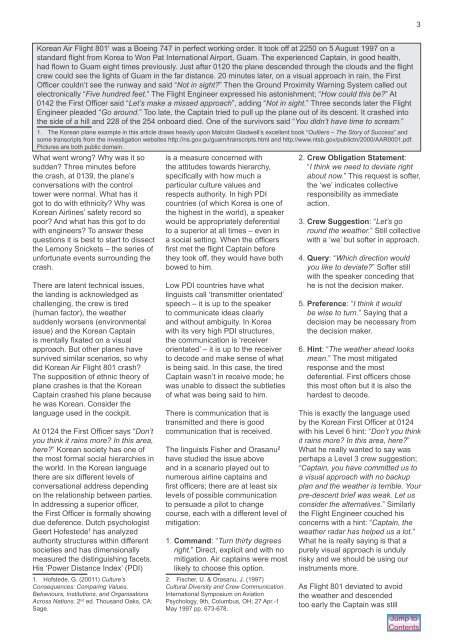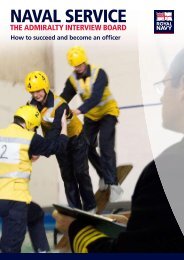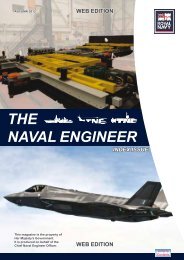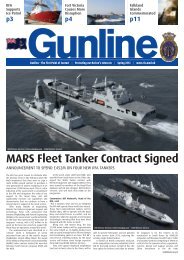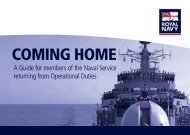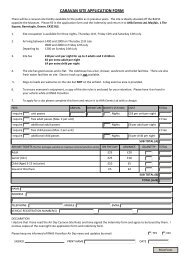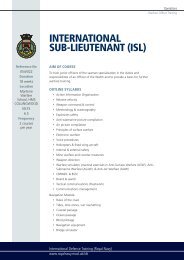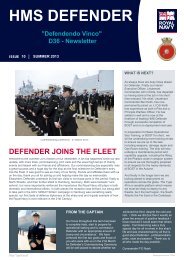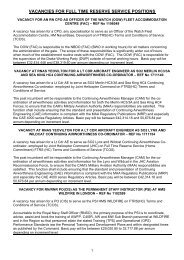THE NAVAL ENGINEER
THE NAVAL ENGINEER
THE NAVAL ENGINEER
You also want an ePaper? Increase the reach of your titles
YUMPU automatically turns print PDFs into web optimized ePapers that Google loves.
3<br />
Korean Air Flight 801 1 was a Boeing 747 in perfect working order. It took off at 2250 on 5 August 1997 on a<br />
standard flight from Korea to Won Pat International Airport, Guam. The experienced Captain, in good health,<br />
had flown to Guam eight times previously. Just after 0120 the plane descended through the clouds and the flight<br />
crew could see the lights of Guam in the far distance. 20 minutes later, on a visual approach in rain, the First<br />
Officer couldn’t see the runway and said “Not in sight?” Then the Ground Proximity Warning System called out<br />
electronically “Five hundred feet.” The Flight Engineer expressed his astonishment; “How could this be?” At<br />
0142 the First Officer said “Let’s make a missed approach”, adding “Not in sight.” Three seconds later the Flight<br />
Engineer pleaded “Go around.” Too late, the Captain tried to pull up the plane out of its descent. It crashed into<br />
the side of a hill and 228 of the 254 onboard died. One of the survivors said “You didn’t have time to scream.”<br />
1. The Korean plane example in this article draws heavily upon Malcolm Gladwell’s excellent book “Outliers – The Story of Success” and<br />
some transcripts from the investigation websites http://ns.gov.gu/guam/transcripts.html and http://www.ntsb.gov/publictn/2000/AAR0001.pdf.<br />
Pictures are both public domain.<br />
What went wrong? Why was it so<br />
sudden? Three minutes before<br />
the crash, at 0139, the plane’s<br />
conversations with the control<br />
tower were normal. What has it<br />
got to do with ethnicity? Why was<br />
Korean Airlines’ safety record so<br />
poor? And what has this got to do<br />
with engineers? To answer these<br />
questions it is best to start to dissect<br />
the Lemony Snickets – the series of<br />
unfortunate events surrounding the<br />
crash.<br />
There are latent technical issues,<br />
the landing is acknowledged as<br />
challenging, the crew is tired<br />
(human factor), the weather<br />
suddenly worsens (environmental<br />
issue) and the Korean Captain<br />
is mentally fixated on a visual<br />
approach. But other planes have<br />
survived similar scenarios, so why<br />
did Korean Air Flight 801 crash?<br />
The supposition of ethnic theory of<br />
plane crashes is that the Korean<br />
Captain crashed his plane because<br />
he was Korean. Consider the<br />
language used in the cockpit.<br />
At 0124 the First Officer says “Don’t<br />
you think it rains more? In this area,<br />
here?” Korean society has one of<br />
the most formal social hierarchies in<br />
the world. In the Korean language<br />
there are six different levels of<br />
conversational address depending<br />
on the relationship between parties.<br />
In addressing a superior officer,<br />
the First Officer is formally showing<br />
due deference. Dutch psychologist<br />
Geert Hofestede 1 has analyzed<br />
authority structures within different<br />
societies and has dimensionally<br />
measured the distinguishing facets.<br />
His ‘Power Distance Index’ (PDI)<br />
1. Hofstede, G. (20011) Culture’s<br />
Consequences: Comparing Values,<br />
Behaviours, Institutions, and Organisations<br />
Across Nations. 2 nd ed. Thousand Oaks, CA:<br />
Sage.<br />
is a measure concerned with<br />
the attitudes towards hierarchy,<br />
specifically with how much a<br />
particular culture values and<br />
respects authority. In high PDI<br />
countries (of which Korea is one of<br />
the highest in the world), a speaker<br />
would be appropriately deferential<br />
to a superior at all times – even in<br />
a social setting. When the officers<br />
first met the flight Captain before<br />
they took off, they would have both<br />
bowed to him.<br />
Low PDI countries have what<br />
linguists call ‘transmitter orientated’<br />
speech – it is up to the speaker<br />
to communicate ideas clearly<br />
and without ambiguity. In Korea<br />
with its very high PDI structures,<br />
the communication is ‘receiver<br />
orientated’ – it is up to the receiver<br />
to decode and make sense of what<br />
is being said. In this case, the tired<br />
Captain wasn’t in receive mode; he<br />
was unable to dissect the subtleties<br />
of what was being said to him.<br />
There is communication that is<br />
transmitted and there is good<br />
communication that is received.<br />
The linguists Fisher and Orasanu 2<br />
have studied the issue above<br />
and in a scenario played out to<br />
numerous airline captains and<br />
first officers; there are at least six<br />
levels of possible communication<br />
to persuade a pilot to change<br />
course, each with a different level of<br />
mitigation:<br />
1. Command: “Turn thirty degrees<br />
right.” Direct, explicit and with no<br />
mitigation. Air captains were most<br />
likely to choose this option.<br />
2. Fischer, U. & Orasanu, J. (1997)<br />
Cultural Diversity and Crew Communication.<br />
International Symposium on Aviation<br />
Psychology, 9th, Columbus, OH; 27 Apr.-1<br />
May 1997 pp. 673-678.<br />
2. Crew Obligation Statement:<br />
“I think we need to deviate right<br />
about now.” This request is softer,<br />
the ‘we’ indicates collective<br />
responsibility as immediate<br />
action.<br />
3. Crew Suggestion: “Let’s go<br />
round the weather.” Still collective<br />
with a ‘we’ but softer in approach.<br />
4. Query: “Which direction would<br />
you like to deviate?” Softer still<br />
with the speaker conceding that<br />
he is not the decision maker.<br />
5. Preference: “I think it would<br />
be wise to turn.” Saying that a<br />
decision may be necessary from<br />
the decision maker.<br />
6. Hint: “The weather ahead looks<br />
mean.” The most mitigated<br />
response and the most<br />
deferential. First officers chose<br />
this most often but it is also the<br />
hardest to decode.<br />
This is exactly the language used<br />
by the Korean First Officer at 0124<br />
with his Level 6 hint: “Don’t you think<br />
it rains more? In this area, here?”<br />
What he really wanted to say was<br />
perhaps a Level 3 crew suggestion;<br />
“Captain, you have committed us to<br />
a visual approach with no backup<br />
plan and the weather is terrible. Your<br />
pre-descent brief was weak. Let us<br />
consider the alternatives.” Similarly<br />
the Flight Engineer couched his<br />
concerns with a hint: “Captain, the<br />
weather radar has helped us a lot.”<br />
What he is really saying is that a<br />
purely visual approach is unduly<br />
risky and we should be using our<br />
instruments more.<br />
As Flight 801 deviated to avoid<br />
the weather and descended<br />
too early the Captain was still<br />
Jump to<br />
Contents


